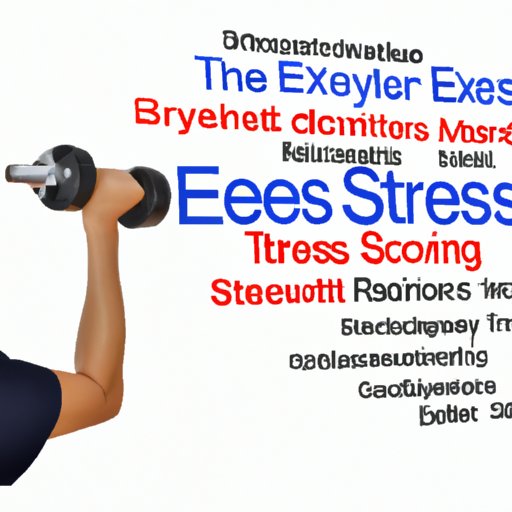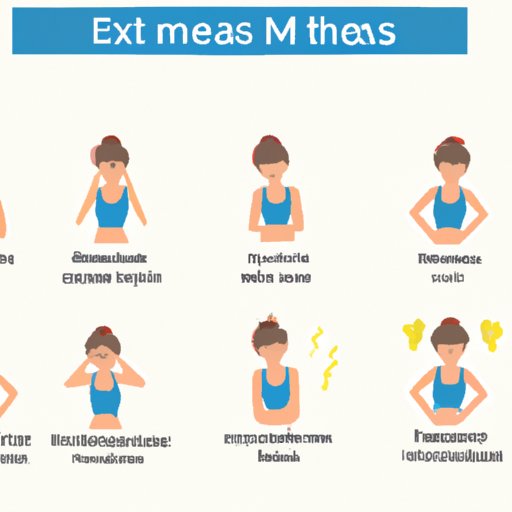Introduction
Mental health is defined as an individual’s emotional, psychological, and social wellbeing. It is determined by a person’s ability to cope with life’s challenges, to build relationships, and to make decisions that contribute to their overall wellbeing. In recent years, there has been an increasing focus on the role of physical activity in improving mental health, with research demonstrating its potential to reduce stress, treat depression, manage anxiety, and enhance cognitive and mood.

Examining the Benefits of Exercise for Stress Reduction
Stress is a normal part of life and can be beneficial in small doses, helping us to stay motivated and focused. However, chronic stress can have a negative impact on our mental and physical health, leading to anxiety, depression, and other mental health issues. Exercise can be an effective way to reduce stress and improve mental health.
Understanding the Physiological Effects of Exercise on Stress
When we exercise, our bodies release endorphins, which are hormones that act as natural painkillers and mood boosters. Endorphins also help to reduce stress levels, providing a feeling of relaxation and improved mood. Exercise also increases blood flow to the brain, which helps to improve concentration and alertness. In addition, regular physical activity can help to regulate cortisol levels, which is the hormone responsible for stress.
Investigating the Role of Exercise in Stress Management
Regular physical activity can be an effective tool for managing stress, as it allows us to take a break from the demands of everyday life and focus on something positive. Exercise can also help to improve our self-esteem and confidence, which can help us to better cope with stressful situations. Additionally, physical activity can provide a distraction from worries and help to clear our minds, allowing us to think more clearly and make better decisions.

Investigating the Role of Physical Activity in Treating Depression
Depression is a serious mental health condition characterized by feelings of sadness, hopelessness, and worthlessness, and can have a significant impact on quality of life. Many people who suffer from depression find it difficult to engage in physical activity, but research has shown that exercise can be an effective treatment for depression.
Exploring the Link Between Exercise and Depression
Exercise can increase the production of serotonin, a neurotransmitter that helps to regulate mood. Additionally, exercise can help to reduce stress, improve sleep quality, and increase energy levels, all of which can help to alleviate symptoms of depression. Regular physical activity can also help to improve self-esteem and confidence, which can help to combat feelings of worthlessness often associated with depression.
Examining the Benefits of Exercise for Depression
Exercise can be an effective tool for treating depression, as it can help to reduce symptoms and improve overall wellbeing. Research has shown that even low-intensity exercise, such as walking or light jogging, can be beneficial for people with depression. Additionally, engaging in physical activity can help to break the cycle of negative thoughts associated with depression, allowing us to focus on something positive.
Understanding the Impact of Exercise on Anxiety Disorders
Anxiety disorders are a group of mental health conditions characterized by persistent and excessive worry. People with anxiety disorders may experience physical symptoms such as racing heart, chest tightness, and difficulty breathing. Exercise can be an effective tool for managing anxiety, as it can help to reduce stress levels and improve overall wellbeing.
Looking at the Link Between Exercise and Anxiety
Exercise can help to reduce anxiety by releasing endorphins, which can help to reduce stress levels and improve mood. Additionally, exercise can help to distract from worries, allowing us to focus on something else and break the cycle of negative thoughts associated with anxiety. Furthermore, physical activity can help to improve self-esteem, which can help to reduce feelings of insecurity and fear often associated with anxiety.
Investigating the Role of Exercise in Managing Anxiety
Regular physical activity can be an effective tool for managing anxiety, as it can help to reduce stress levels and improve overall wellbeing. Research has shown that even low-intensity exercise, such as walking or light jogging, can be beneficial for people with anxiety. Additionally, engaging in physical activity can help to break the cycle of negative thoughts associated with anxiety, allowing us to focus on something positive.
Looking at the Relationship Between Exercise and Cognitive Function
Cognitive function refers to a person’s ability to process information, think logically, and remember things. Cognitive decline is a common problem associated with aging, but research has shown that exercise can be an effective tool for maintaining and improving cognitive function.
Understanding the Link Between Exercise and Cognitive Function
Exercise can help to improve cognitive function by increasing blood flow to the brain, which helps to deliver oxygen and nutrients. Additionally, exercise can help to stimulate the growth of new brain cells and connections, which can help to improve memory and concentration. Furthermore, physical activity can help to reduce stress levels, which can help to improve focus and concentration.
Examining the Role of Exercise in Enhancing Cognitive Function
Regular physical activity can be an effective tool for improving cognitive function, as it can help to increase blood flow to the brain, stimulate the growth of new brain cells and connections, and reduce stress levels. Research has shown that even low-intensity exercise, such as walking or light jogging, can be beneficial for cognitive function. Additionally, engaging in physical activity can help to break the cycle of negative thoughts associated with cognitive decline, allowing us to focus on something positive.

Evaluating the Benefits of Exercise for Mood Enhancement
Mood enhancement refers to a person’s ability to control their emotions and maintain a positive outlook. Research has shown that exercise can be an effective tool for improving mood, as it can help to reduce stress levels and improve overall wellbeing.
Exploring the Link Between Exercise and Mood
Exercise can help to improve mood by releasing endorphins, which can help to reduce stress levels and improve mood. Additionally, exercise can help to distract from worries, allowing us to focus on something else and break the cycle of negative thoughts associated with poor mood. Furthermore, physical activity can help to improve self-esteem, which can help to reduce feelings of worthlessness often associated with poor mood.
Investigating the Role of Exercise in Mood Enhancement
Regular physical activity can be an effective tool for improving mood, as it can help to reduce stress levels and improve overall wellbeing. Research has shown that even low-intensity exercise, such as walking or light jogging, can be beneficial for mood enhancement. Additionally, engaging in physical activity can help to break the cycle of negative thoughts associated with poor mood, allowing us to focus on something positive.
Conclusion
In conclusion, physical activity can have a positive effect on mental health, reducing stress, treating depression, managing anxiety, and enhancing cognitive and mood. Regular physical activity can be an effective tool for improving mental health, as it can help to reduce stress levels, improve mood, and enhance cognitive function. Exercise can also help to reduce symptoms of depression and anxiety, and improve overall wellbeing. Therefore, it is important to encourage further exploration of exercise for mental health.
(Note: Is this article not meeting your expectations? Do you have knowledge or insights to share? Unlock new opportunities and expand your reach by joining our authors team. Click Registration to join us and share your expertise with our readers.)
